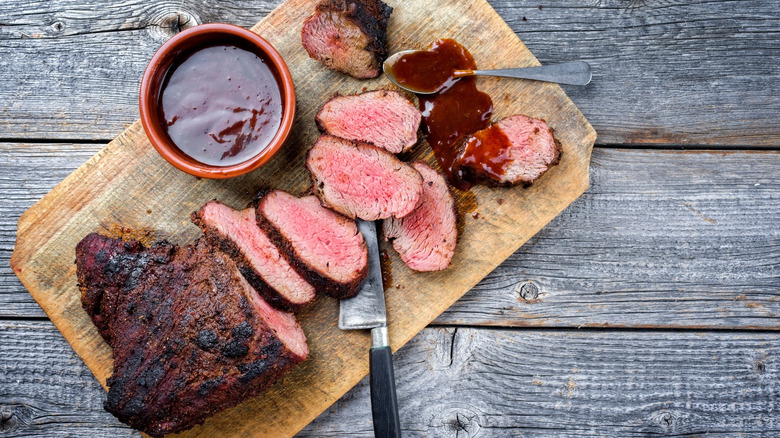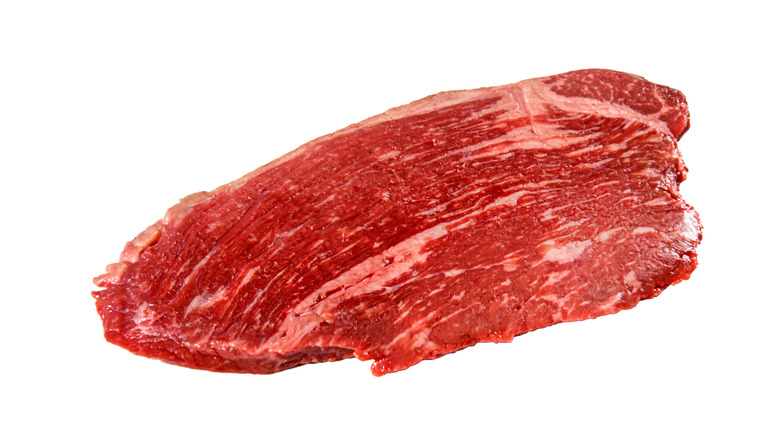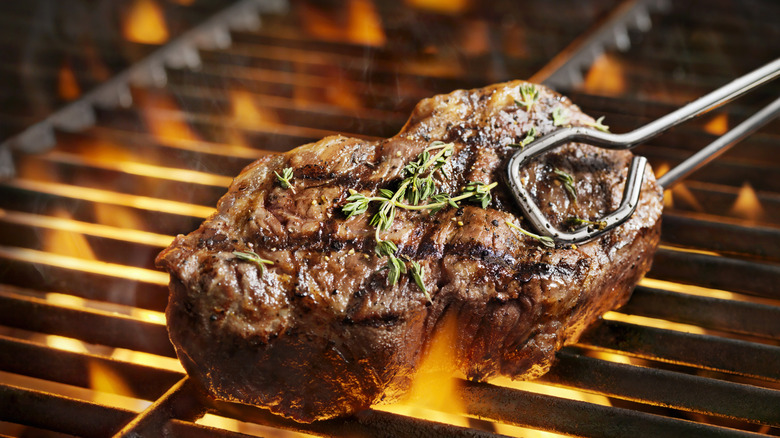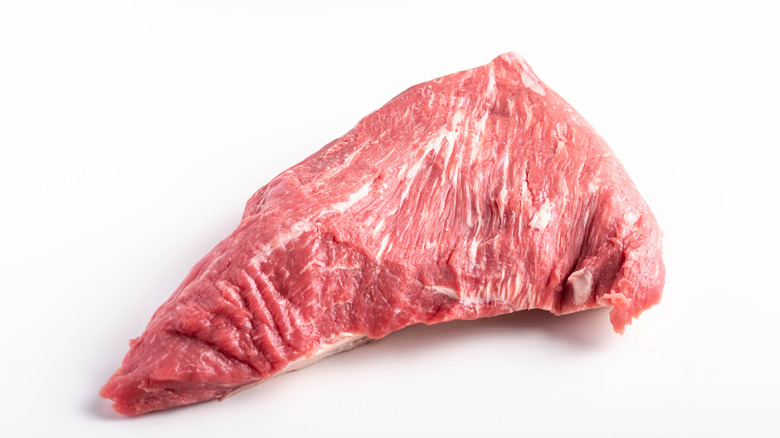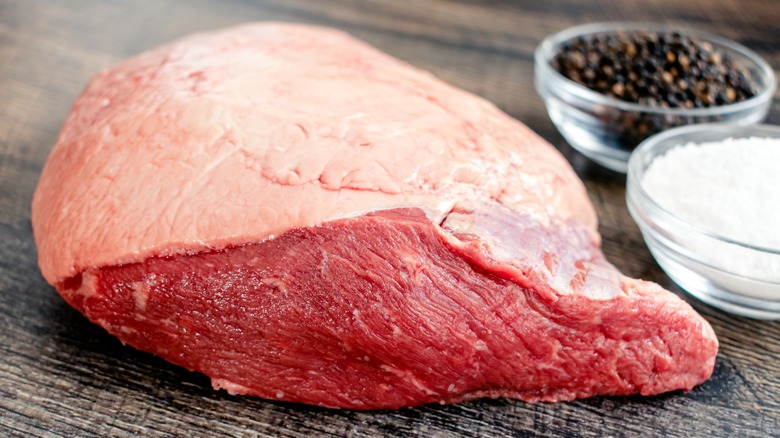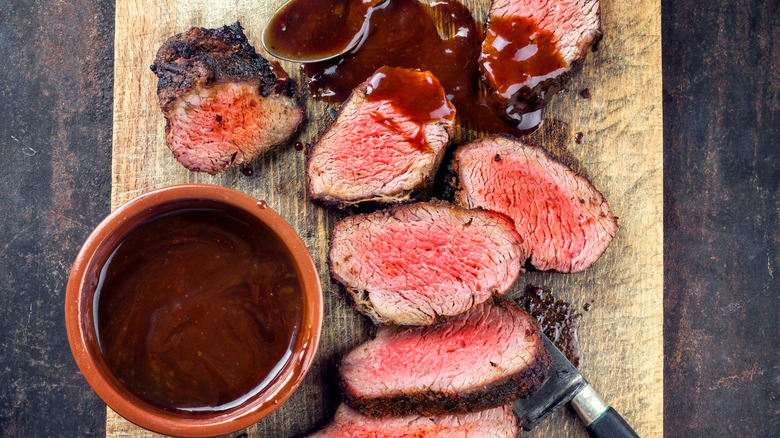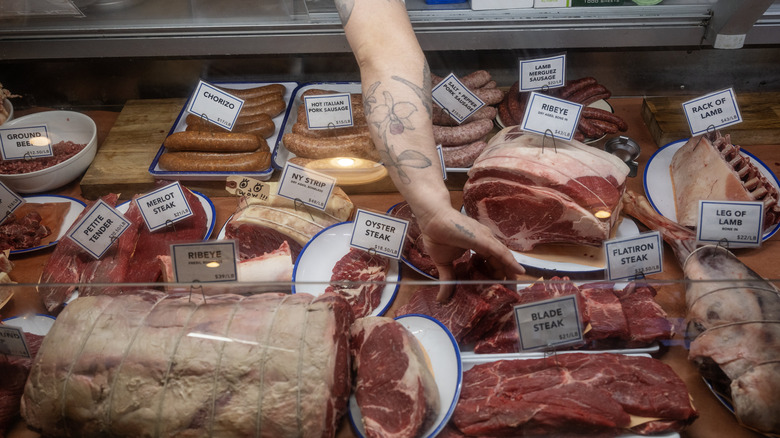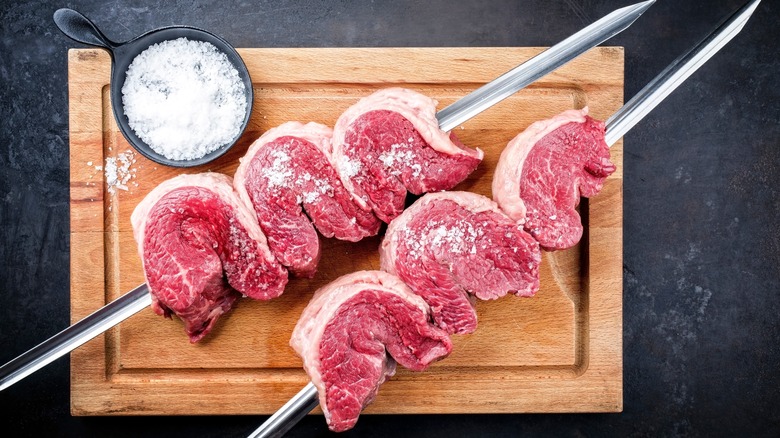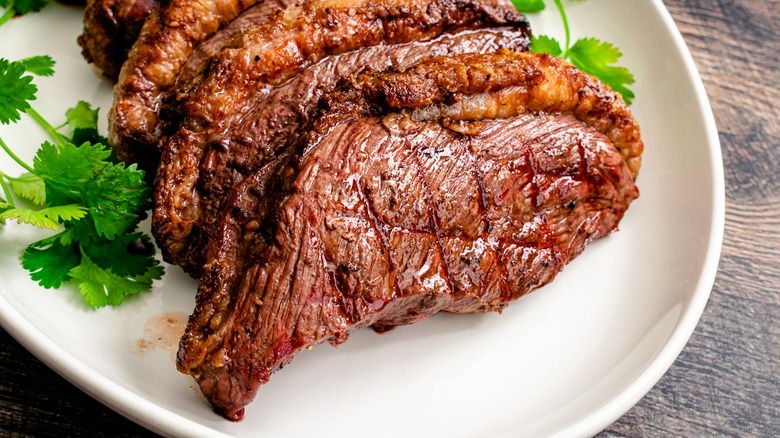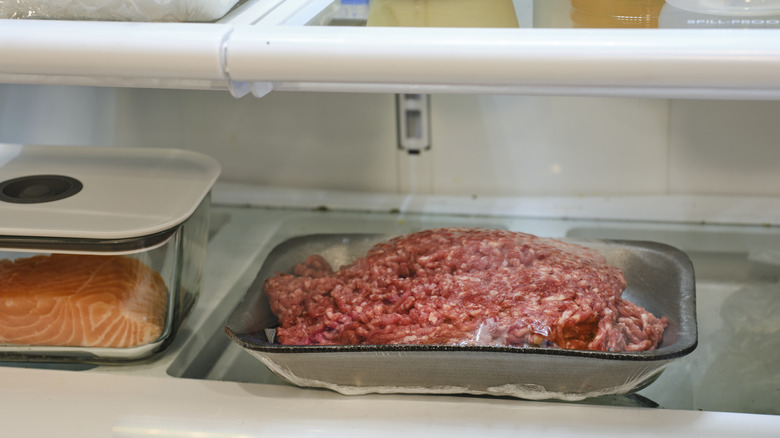What, Exactly, Is Coulotte Steak?
When steak night rolls around, it's never a bad idea to treat yourself to a high-quality piece of beef. As you peer at the various cuts of steak at the butcher shop, one particular variety should catch your eye and perhaps cause your mouth to water. Coulotte steak, also known as sirloin cap or picanha, is a mega-tender cut of beef that's popular among meat enthusiasts for its rich marbling and a perfect balance of tenderness and robust flavor.
Coulotte is a mainstay of Brazilian steakhouses, standing out due to its unique triangular shape with a thick fat cap on one side, which provides a noteworthy succulence. The delicate, artful marbling in the meat further contributes to its lusciousness when prepared properly. Whether you choose to grill, roast, or pan-sear, this versatile slice of goodness promises a satisfying dinner. Experimenting with different seasonings, sides, and techniques allows you to tailor this fine steak to your palate.
What is coulotte steak?
Coulotte steak certainly isn't the most common option to find on a steak menu or in a butcher's case. However, this long, underappreciated cut is rapidly gaining in popularity and, thus, in availability. Hailing from the sirloin primal, which is located between the loin and the round, near the cow's hip, coulotte comes more specifically from the top sirloin butt subprimal, where it shares space with beloved, better-known cuts like top sirloin filet and top sirloin steak. Its name may be an indicator of its geographic location, with many theorizing it comes from the French word "culot" or cap, though experts remain divided on its true source. Coulotte may also be sold under other names, including picanha or rump cap.
While coulotte steak itself is typically leaner than many others on the cow, it is usually sold with a thick fat cap on top. The steak itself is long and narrow — about two inches wide, four inches long, and just a ½ inch thick — making it the perfect size to cook up quickly on a weeknight.
Differences between coulotte steak and sirloin steak
Seeing as coulotte comes from the sirloin primal, it would be easy to confuse sirloin steaks and coulotte steaks. That said, there are a few big differences between the two. Perhaps the easiest way to think of it is that while coulotte steak does indeed hail from the sirloin, not all sirloin steaks are coulotte steaks. Sirloin steaks can come either from the top or bottom sirloin butt; the petite sirloin, sirloin bavette, sirloin flap, and petite sirloin or ball tip all come from the bottom sirloin butt, whereas the top sirloin filet, top sirloin steak, and top sirloin butt all come, like the coulotte steak, from the top sirloin butt.
Sirloin steaks can be cut into many different shapes and sizes, from filet-style (aka baseball cut) to strip-style, which looks much like a classic steakhouse New York strip. Sirloin strip steaks tend to come from the short loin area closer to the back end of the cow and have a firmer texture than steaks from the top sirloin, including the coulotte, which are usually more flavorful than steaks from the bottom sirloin butt.
Differences between coulotte steak and tri-tip
It's easy to confuse coulotte with other similar steaks hailing from the sirloin primal, especially tri-tip. Both steaks, after all, are triangular in shape and boast good flavor. But there are some major differences between them to keep in mind when deciding which steak to source.
Tri-tip comes from the bottom sirloin subprimal, as opposed to coulotte, which comes from the top. Also known as Newport steak or "poor man's brisket," tri-tip was long relegated to the ground meat section of the butcher's case before rising to popularity, first in California. These days, it's beloved by many thanks to its even marbling, which means it has even more buttery flavor than coulotte, which is leaner but has a fat cap that tri-tip lacks. Tri-tip also isn't quite as tender as coulotte, meaning it's generally a good idea to slice it into thinner slices before serving.
Differences between coulotte steak and picanha
Coulotte and picanha may sound super different, but at the end of the day, these are just two terms for the same cut of beef. Picanha is the Portuguese word for coulotte steak, and these days, it's become a popular way to refer to the cut even in English thanks to its popularity in Brazil: The rise in Brazilian churrascarias or steakhouses in the U.S. is a large part of what has contributed to ever-increasing awareness and popularity of this tasty cut. And given their mastery of it, it's not hard to see why.
"It's crazy tender with a beautiful fat cap that just melts and crisps as you cook it," says ButcherBox chef Yankel Polak in a story published by ButcherBox on Medium. "Sliced thin and against the grain, this hunk of sirloin will literally melt in your mouth when treated properly, which is medium rare or skewered and slow roasted over an open fire."
Despite these terms referring to exactly the same cut, butchering standards may mean you encounter a few differences between coulotte and picanha in the U.S. Picanha typically boasts a thicker layer of fat than coulotte, which is often trimmed before being sold.
What does coulotte steak taste like?
Coulotte steak manages to tow that perfect line between being relatively lean and supremely flavorful. The rich fat cap tends to melt when heated, and especially when grilled, it permeates the already flavorful steak with a delicious, savory, smoky note.
As with many cuts of beef, however, much of the flavor of coulotte steak comes not just from the steak itself but how it is cooked. When prepared in the traditional Brazilian fashion — on a rotating skewer set over charcoal — the fat cap melts slowly and is absorbed into the meat. The resulting steak is richer and butterier, taking on a lovely char-grilled flavor to boot. Especially when cooked in this fashion, coulotte steak is a bit tenderer than New York strip yet boasts all the flavor of sirloin. Is it any surprise it's such a favorite among steak lovers ... and perhaps Brazil's favorite steak?
How to buy coulotte steak
Coulotte steak is fairly affordable, all things considered, usually coming in at around $10 a pound. It's typically slightly more expensive than a top sirloin butt steak but on par with a tri-tip. Typically, choosing grass-fed coulotte steak is more expensive than grain-fed due to the increased production costs of this more humane way of raising beef cattle. Grass-fed beef also boasts a better nutritional profile than grain-fed, with more heart-healthy omega-3 and omega-6 fatty acids, not to mention more antioxidant vitamin E.
Coulotte steak used to be hard to find at butcher shops, but it's becoming far more popular, in large part thanks to the growing popularity of Brazilian steakhouses. That said, if you can't find it at your local butcher shop or supermarket, you can easily track down coulotte steak online. Grass-fed, grain-finished coulotte steak offers a best-of-both-worlds appeal with most of the health benefits of grass-fed with added flavor thanks to the addition of grain to the cows' diet towards the end of their lives.
How to cook with beef coulotte
There are various tried-and-true methods of cooking coulotte steak that bring out its best qualities and yield a memorable meal. Grilling, of course, is the go-to strategy for many, as the high heat helps sear the exterior, locking in juices and creating a crispy crust. Before grilling, it's best to season the steak generously with salt and pepper or a dry rub. Another popular method is roasting, which ensures even doneness and a caramelized exterior.
For those looking for a quicker option, pan-searing coulotte steak is another great choice that gets the job done in mere minutes. Simply sear the steak in a hot skillet with oil, flipping it to achieve a golden-brown crust on both sides. Regardless of the cooking method you opt to use — and as tempting as it may be to dig in immediately — it's crucial to let the steak rest for a few minutes before slicing it. This much-needed intermission allows the juices and melted fat from the fat cap to redistribute throughout the lean loin.
Pairing coulotte steak with the right savory side dishes can enhance the overall dining experience, creating a rollercoaster in every bite. For example, consider serving your steak with an array of roasted vegetables, a zippy chimichurri, or a classic, buttery béarnaise sauce recipe. Coulotte also makes for an excellent ingredient in kabobs, salads, sandwiches, and other fare.
Nutritional information about beef coulotte
Beef coulotte is leaner than many other steaks, with a fat content of just six grams per four-ounce serving, as compared to over 14 for the same amount of ribeye, and seeing as the fat cap of coulotte can be trimmed if you like, it's easy to reduce the fat content of this cut considerably.
Four ounces of coulotte also contains 210 calories and a whopping 24 grams of protein. The protein content of coulotte steak — as with all beef — is rich in all nine essential amino acids and indeed is almost identical to human muscles from the perspective of these essential nutrients, making it a particularly good choice for athletes or for those recovering from surgery looking to build or rebuild muscle mass. Beef is also rich in several vitamins and minerals, including zinc, selenium, iron, and phosphorous. It also boasts essential B vitamins B12, B6, and niacin (B3), which contribute to improved blood formation and energy metabolism and may even reduce the risk of heart disease.
A word of warning, however: Overconsumption of red meat has been linked to an increased risk of heart disease. It's important to moderate consumption of coulotte steak — and all beef — interspersing it with heart-healthy plant- or fish-based options.
How to store coulotte steak
When shopping for fresh beef, look for firm cuts with a bright red color and nice, even marbling. Be sure to keep beef cold when transporting it home, using ice packs or a cooler if needed. Transfer it immediately to the fridge upon returning home, keeping it in a sealed package or covered container until ready to cook and consume.
Be sure to keep fresh beef at the bottom of the refrigerator; this reduces the risk of contaminating other items in your fridge should it drip. Do not keep raw beef in the fridge for any longer than three to five days. If you don't plan to consume your coulotte steak within this window, it can be safely frozen for four to twelve months. Freezing beef in a sous-vide pouch is one of the best ways to ensure it stays fresher longer and reduces the risk of freezer burn. Always defrost frozen beef by setting it on a plate in the fridge the night before you hope to cook it; this slow defrosting will ensure it always remains at a safe temperature.
